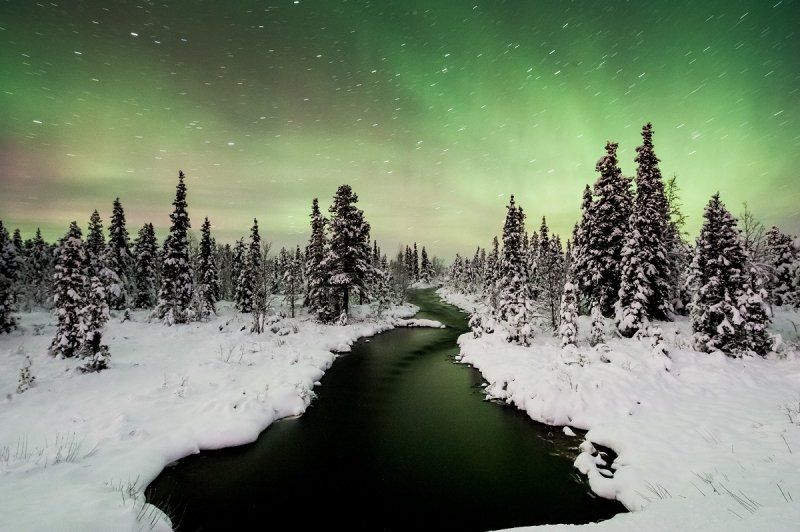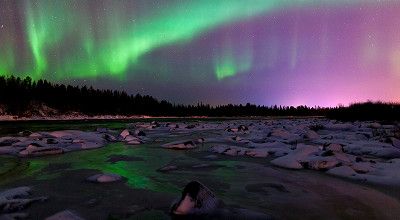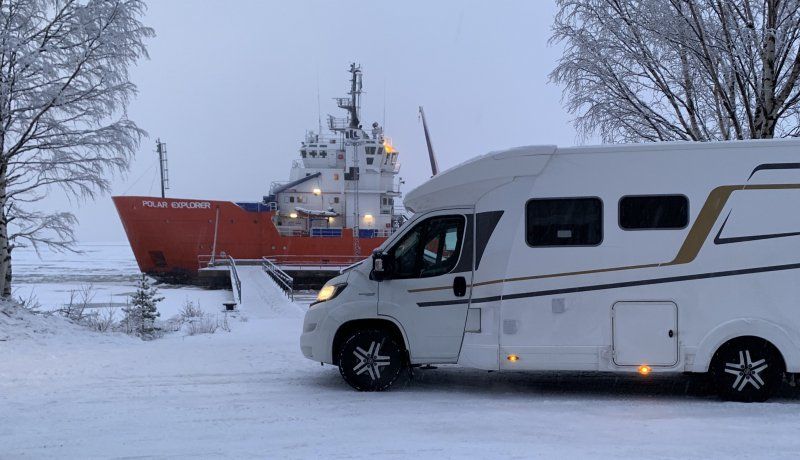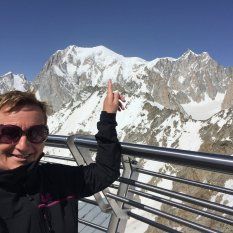Latest update: October 23rd, 2023
One natural phenomenon has inspired a host of people to pack their suitcases or backpacks and to head northwards in the hope of catching a glimpse of it: the aurora borealis – also known as the Northern Lights or polar light. The only problem is that nobody can accurately predict if, where and when the aurora borealis will perform its magical dance in the sky. However, Freeontour has located three places in northern Scandinavia where the chances of a sighting are pretty high, especially in February and March. So why not make the chase more pleasant by combining it with a short motorhome tour?

What is the best time of year to chase the Northern Lights?
This question is almost impossible to answer reliably. February is supposedly the best time to chase the Northern Lights in the north of Scandinavia. But even then you might not get to witness this magnificent light show. You could even get lucky with a nightly performance in August because contrary to the widespread belief that the aurora borealis is only active in winter, it does in fact not stop during the summer months. However, you cannot see it due to the bright skies in Norway, Finland and Sweden. This is why the darker months (September to March) are considered to be the actual aurora borealis season.
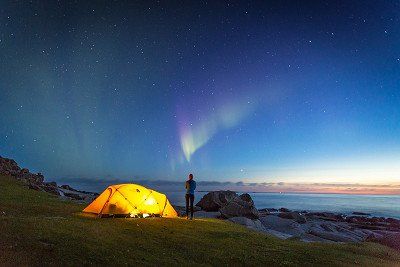
It is also often claimed that it has to be very cold to see the Northern Lights, yet there is no scientific evidence for this. This myth may have come about because the aurora borealis is obviously best seen when the sky is clear – when the temperature seems to be colder than when it is cloudy. In fact, statistics from the past few years have shown that very bright aurora borealis events have occurred more frequently in September, October, February and March than between November and January, the coldest months of the year. Scientists are still unsure why this is the case, but one thing is certain: if you want to combine winter activities such as snowmobiling, dog sledding, snowshoeing or skiing with an aurora borealis chase, head to the north of Norway, Sweden and Finland in February and March as it is not as cold or dark there as in January or December.

What are the best places to see the aurora borealis?
To start with, the destination should be within the auroral oval or polar oval. This is a circular zone around the polar cap that stretches between 70 and 80 degrees geomagnetic latitude, and it is this area above the Arctic Circle that will provide you with the best chance of seeing the aurora borealis. Another tip: stay as far away from civilization as possible. The less stray light from towns, street lamps, cars, etc. there is, the better you will be able to see this celestial phenomenon – not forgetting the distinctive rustling sound of the aurora borealis that is much more audible in the great outdoors than near towns.
Moreover, when chasing the Northern Lights, be patient and bring plenty of time. If you have only planned on spending one or two nights within the auroral oval, you may have to go back home without having seen this magical celestial spectacle due to unfavourable weather conditions. As the cloud cover is always changing, an aurora hunter also needs to be mobile and not just stay in one place. Accordingly, numerous companies in the touristy north of Norway, Sweden and Finland now specialise in aurora tours and are constantly chasing the aurora borealis in their vehicles. Many hotels and campsites that are open in winter also notify their guests by SMS or Messenger as soon as the Northern Lights appear in the sky. Simply put: you need to be just as flexible as Mother Nature herself.

Furthermore, solar activity also influences the aurora borealis phenomenon. A solar cycle usually lasts about eleven years. Its periods of low and high activity affect the frequency of auroras, which is greatest during the intense phase in the middle of the cycle. The last solar maximum was in 2013/2014; the last cycle ended in the winter of 2019/2020 with a solar minimum. As a result, a new sunspot cycle began in autumn 2020 – the 25th one since records began in 1749. Therefore, solar activity is on the increase again and approaching a new maximum. It is expected in winter 2023/24 at the very earliest, but more likely to occur in winter 2024/25. Nevertheless, the chances for a sighting are really increasing this winter and there are a few sites where the chances of a sighting are probably slightly greater than elsewhere. Freeontour has put together the best aurora borealis places in Norway, Sweden and Finland – a good enough reason for a Northern Lights tour in a motorhome!

The best place for the Northern Lights in Sweden: Abisko National Park & Aurora Sky Station
One of the best places in Sweden to see the Northern Lights is Abisko National Park in Swedish Lapland. It lies in the middle of the auroral zone between the 65th and 72nd parallel, north-west of Kiruna near the Norwegian border, and covers an area of 77 square kilometres. Moreover, the climate here is comparatively dry, which makes for clear skies. Most notably, the Aurora Sky Station is also located here at an altitude of 900 m on Mount Nuolja, which you can easily access by chairlift from Abisko, even in winter. There is no artificial extraneous light on Nuolja, so that your experience of the aurora borealis is completely undisturbed and pollution-free. The Aurora Sky Station not only has a large outdoor viewing platform on top of the mountain, but also large panoramic windows should you prefer to observe the aurora borealis from inside the station. You can also treat yourself to an exclusive 4-course meal here to sweeten the wait for a glimpse of the Northern Lights. Campsites and parking spaces for winter camping can be found nearby in Björkliden and Riksgränsen.

The best place for the Northern Lights in Norway: Tromsø
Another hotspot for aurora hunters in Scandinavia is Tromsø in Northern Norway. Most people would expect Norway to have more and better places with less light pollution to observe the aurora borealis – some particularly beautiful locations include Lofoten, Vesterålen and Spitsbergen. However, tourists tend to prefer Tromsø as it is easy to get to. Accordingly, numerous companies have set up business here to drive tourists to the mountains around Tromsø when the Northern Lights are active. If you take part, you will be provided with warm snow overalls, hot drinks and snacks while waiting for this natural phenomenon to make its appearance. But if you do not want to watch the aurora borealis surrounded by lots of people and coaches, you could drive around in your own vehicle or even take the Fjellheisen cable car to Mount Storsteinen where you can wait and watch in the warm Fjellstua restaurant at the mountain station.

The best place for the Northern Lights in Finland: Inari, Ivalo & Nellim
The villages of Inari, Ivalo and Nellim lie not far from each other in the far north of Finland. Statistics show that the Northern Lights can be observed here on roughly 200 nights a year. After all, there is hardly any traffic and light pollution from artificial light sources in the very north of Lapland. So it is hardly surprising that numerous providers in this region offer a range of experiences and activities revolving around the aurora borealis, e.g. photography courses where you can learn how to best capture the Northern Lights on camera. Moreover, you will come across many more places in the Finnish part of Lapland on your hunt for the Northern Lights, even with quirky accommodation. Below is just one great example:


